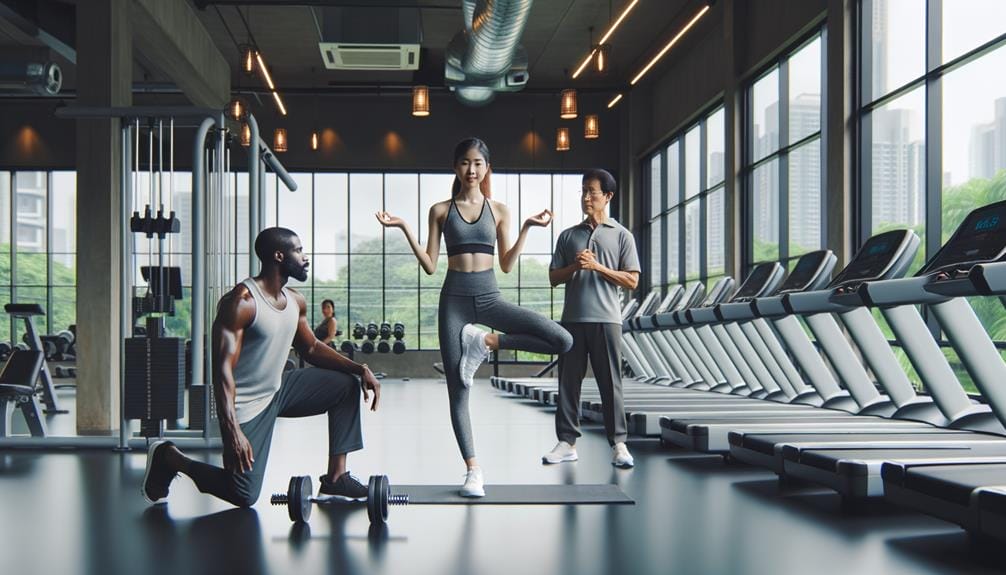Avoid fitness injuries by following these key strategies. Start with a proper warm-up, including light cardio and dynamic stretching, to prepare your muscles. Maintain proper form in every exercise to prevent strains and joint pain—essential guidance can help. Gradually increase the intensity of your workouts, listening to your body's signals. Stay hydrated before, during, and after exercise to guarantee peak performance and recovery. Pay attention to signs of serious injuries, such as severe pain or dizziness, and seek medical help if needed. Using correct equipment is vital, as well. Explore further to enhance your fitness routine safely.
Key Takeaways
- Warm up with light cardio and dynamic stretching for 5-10 minutes.
- Maintain proper exercise form to avoid strains and joint pain.
- Gradually increase workout intensity to reduce injury risk.
- Stay hydrated before, during, and after workouts for optimal function.
- Use well-fitting gear and regularly check equipment for wear and tear.
Common Causes of Injuries
Before you start your workout, understanding the common causes of injuries is crucial.
First off, exercising without warming up is like trying to sprint before you've had your morning coffee—hello, muscle strains!
Repeating the same motion excessively? That's your VIP pass to overuse injuries like tendonitis.
Incorrect exercise form? Congratulations, you've just invited strains and joint pain to your fitness party.
Then there's inadequate rest between workouts, which leads to fatigue and potential injuries faster than you can say 'nap time.'
Lastly, excessive or rapid exertion is a surefire way to muscle tears and sprains.
Proper Warm-Up Techniques

Regularly incorporating proper warm-up techniques into your routine can drastically reduce your risk of workout injuries. Don't just jump right into your exercise like you're cannonballing into a pool! Instead, start with some light cardio—think jogging or jumping jacks.
Follow that up with dynamic stretching, which means moving while you stretch. Imagine you're a marionette puppet doing leg swings, arm circles, or walking lunges. These moves boost blood flow, flexibility, and muscle activation.
Spend about 5-10 minutes on these activities to properly warm up your muscles and gradually increase your heart rate. Trust me, a good warm-up helps prevent injuries and makes your workout more effective.
Importance of Form
Maintaining proper form during exercise is vital to avoid injuries and make sure you're getting the most out of your workout. Incorrect techniques can cause muscle strains and joint pain, while proper alignment and stability help engage muscles efficiently.
Proper Technique Matters
Mastering proper technique is essential to minimizing the risk of injuries during your workouts. Incorrect form can lead to muscle strains, joint pain, and other injuries that'll have you sidelined faster than you can say 'ouch.'
To keep things injury-free and fun, follow these simple tips:
- Focus on Form: Keep an eye on your posture, making sure you're not turning into the Hunchback of Notre Gym.
- Engage the Right Muscles: Make certain that the muscles you're targeting are actually doing the work, not freeloading while your joints suffer.
- Get Professional Guidance: Don't hesitate to ask for help from a fitness pro. They're there to make sure you're not the next viral gym fail.
Alignment and Stability
Ensuring proper alignment and stability during your workouts is essential for preventing injuries and maximizing the effectiveness of each exercise. Think of it as keeping your exercise routine in tip-top shape. When your form's on point, you're distributing weight evenly, which means no single muscle or joint is taking the brunt of the work—goodbye, unnecessary strain! It's like giving your body a health insurance policy.
Proper alignment engages the right muscles, so you get the most out of every move. Plus, stability exercises? They're your best friends for balance and coordination, minimizing the chance of any gym-floor face plants.
Gradual Intensity Increase

When you gradually increase the intensity of your workouts, you help your body adapt and reduce the risk of injuries. This method is your best friend for avoiding muscle strains and overuse injuries.
Jumping straight into high-intensity workouts can lead to those dreaded intensity spikes, which are basically invitations for injuries.
To keep things safe and sound, follow these steps:
- Start Slow: Kick off with low to moderate intensity.
- Progressively Ramp Up: Gradually increase the challenge level week by week.
- Listen to Your Body: Pay attention to how your body responds and adjust accordingly.
Hydration Tips
Staying properly hydrated is essential to avoiding fitness injuries. Let's look at how much water you need, when to drink it, and how to recognize dehydration.
Aim to drink water before, during, and after your workouts to keep your body functioning at its best. Watch for signs like dark urine, which indicates you need to drink more water.
Optimal Water Intake
Drinking enough water is essential for keeping your body performing its best and preventing injuries during exercise. Proper hydration is the secret sauce to stellar exercise performance and ensuring you stay hydrated.
Here's a simple guide to fluid replenishment:
- Pre-workout: Drink 17-20 ounces of water 2-3 hours before you start. Think of it as priming your engine.
- During exercise: Guzzle 7-10 ounces every 10-20 minutes. Yes, you can pretend you're a marathoner even if you're just in spin class.
- Post-workout: Within 30 minutes of sweating it out, down 8 ounces to kickstart recovery.
Hydration Timing Strategies
To maximize your workout efficiency and prevent dehydration, it's crucial to time your hydration strategically. Start your exercise program by drinking 17-20 ounces of water 2-3 hours before hitting the gym.
During your sweat session, aim to hydrate with 7-10 ounces every 10-20 minutes. Think of it like a hydration pit stop—minus the tires.
For workouts longer than an hour, consider electrolyte-rich drinks to keep those minerals in check. Monitoring your urine color can also help; aim for a pale yellow hue.
Proper hydration isn't just about guzzling water. It's your ticket to safe exercise, better muscle function, and quicker recovery. So, raise that water bottle and prevent dehydration like a pro!
Signs of Dehydration
Recognizing the signs of dehydration is essential for maintaining peak performance and preventing serious health issues during workouts. You've got to know when your body's calling for water or electrolytes. Here are some telltale signs:
- Dark Urine: If it's looking more like apple juice than lemonade, you're dehydrated.
- Dry Mouth: That Sahara Desert feeling isn't normal—drink up!
- Dizziness and Fatigue: If you feel like you're on a merry-go-round, it's time for water.
Don't wait until you're thirsty—thirst is a late sign of dehydration. Keep sipping water before, during, and after your workouts.
For those intense, sweaty sessions, consider an electrolyte-rich beverage to keep things balanced.
Stay hydrated, and your body will thank you!
Effective Cool Down

Imagine this: after a tough workout, your muscles are screaming, “Why did you do this to us?” A cool down, including stretching, can help prevent muscle soreness and keep injuries at bay.
Spend 5-10 minutes doing light aerobic activity, like walking or gentle cycling, to gradually lower your heart rate and body temperature. This helps your muscles relax and prevents blood from pooling in your extremities. Plus, stretching improves flexibility and reduces muscle tension.
Think of it as your muscles' well-deserved spa time. So, don't skimp on the cool down—it's your secret weapon against post-exercise woes.
Listening to Your Body

Your body sends important signals during workouts, and it's crucial to listen to them to avoid injuries. If you feel pain, don't be a hero—stop immediately. Ignoring these signals can lead to serious issues.
Here's how you can help prevent injury:
- Adjust workout intensity: If you notice muscle fatigue or tightness, dial it back. There's no award for pushing through unnecessary pain.
- Rest muscles: Sore muscles need some TLC. Give them a break to recover and come back stronger.
- Switch exercises: If something feels off, change it up. Variety isn't just the spice of life; it's also the key to avoiding overuse injuries.
When to Seek Medical Help
Don't ignore persistent pain; sometimes, it's a sign that you need to seek medical help. If muscle or joint pain refuses to pack its bags and leave despite rest or self-care, it's time to consult a healthcare provider.
Chest pain during or after exercise? Drop the weights and grab your phone for medical advice, pronto!
Suspect a broken bone during your favorite sport? Don't play hero—get immediate medical assistance.
Severe pain, excessive bleeding, or sudden joint issues are like the annoying neighbors you can't ignore—they need prompt attention.
Conclusion
By following these guidelines, you'll greatly reduce your risk of fitness injuries. Don't think you're invincible; even seasoned athletes get hurt by neglecting proper form and warm-ups.
Listen to your body, hydrate properly, and increase your workout intensity gradually. If you do experience pain, don't hesitate to seek medical help.
Staying safe while exercising isn't just about avoiding injuries—it's about ensuring you can continue to enjoy and benefit from your fitness routine long-term.









Leave a Comment